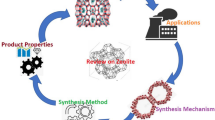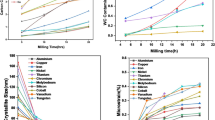Abstract
A Hungarian natural zeolite was mechanically activated by grinding in a Netzsch MiniCer stirred media mill for various activation times from 0 to 480 min. The research goal was to produce submicron-size activated zeolite with narrow particle size distribution and to investigate the energetic aspects of grinding and material characteristics. During mechanical activation (MA) the grinding energy was measured and stress energy was calculated. Additionally, the particle size distribution of the product was characterized by a Horiba 950 LA laser particle size analyzer (LPSA). Furthermore, the BET specific surface area and adsorption capacity of the MA zeolite were measured using TriStar 3000 apparatus and methylene blue adsorption test, respectively. The structural characterization of mechanically activated zeolite was carried out using Rietveld refinement on X-ray powder diffractometry data, Fourier transform infrared spectroscopy and transmission electron microscopy (TEM-EDS). TEM images and LPSA data of MA zeolite revealed the presence of particles below 100 nm. Significant amorphization, as well as the decrease in clinoptilolite phase, was found during entire MA process, while methylene blue adsorption was maintained. Finally, the relationship between grinding operating parameter (specific grinding energy) and material characteristics (amorphous content, the crystallite size of quartz and clinoptilolite) was created.








Similar content being viewed by others

References
Romeis S, Schmidt J, Peukert W (2016) Mechanochemical aspects in wet stirred media milling. Int J Miner Process 156:24–31. https://doi.org/10.1016/j.minpro.2016.05.018
Juhasz AZ, Opoczky L (1990) Mechanical activation of minerals by grinding pulverizing and morphology of particles. Halsted Press, New York
Baláz P (2008) Mechanochemistry in nanoscience and minerals engineering. Springer, Berlin
Klabunde KJ (2001) Nanoscale materials in chemistry. Wiley, Hoboken
Lines MG (2008) Nanomaterials for practical functional uses. J Alloys Compd 449:242–245
Rhodes MJ (2008) Introduction to particle technology. Wiley, Hoboken
Boldyrev VV, Tkáčová K (2000) Mechanochemistry of solids: past, present, and prospects. J Mater Synth Process 8:121–132. https://doi.org/10.1023/A:1011347706721
Baláž P (2000) Extractive metallurgy of activated minerals. Elsevier, New York
Kwade A (1999) Wet comminution in stirred media mills—research and its practical application. Powder Technol 105:14–20. https://doi.org/10.1016/S0032-5910(99)00113-8
Malekian R, Abedi-Koupai J, Eslamian SS et al (2011) Ion-exchange process for ammonium removal and release using natural Iranian zeolite. Appl Clay Sci 51:323–329. https://doi.org/10.1016/j.clay.2010.12.020
Colella C, Wise WS (2014) The IZA handbook of natural zeolites: a tool of knowledge on the most important family of porous minerals. Microporous Mesoporous Mater 189:4–10. https://doi.org/10.1016/j.micromeso.2013.08.028
Terzić A, Pezo L, Andrić L (2017) Chemometric assessment of mechano-chemically activated zeolites for application in the construction composites. Compos Part B Eng 109:30–44. https://doi.org/10.1016/j.compositesb.2016.10.040
Favvas EP, Tsanaktsidis CG, Sapalidis AA et al (2016) Clinoptilolite, a natural zeolite material: structural characterization and performance evaluation on its dehydration properties of hydrocarbon-based fuels. Microporous Mesoporous Mater 225:385–391. https://doi.org/10.1016/j.micromeso.2016.01.021
Kusuma RI, Hadinoto JP, Ayucitra A et al (2013) Natural zeolite from Pacitan Indonesia, as catalyst support for transesterification of palm oil. Appl Clay Sci 74:121–126. https://doi.org/10.1016/j.clay.2012.04.021
Musyoka NM, Missengue R, Kusisakana M, Petrik LF (2014) Conversion of South African clays into high quality zeolites. Appl Clay Sci 97:182–186. https://doi.org/10.1016/j.clay.2014.05.026
Rida K, Bouraoui S, Hadnine S (2013) Adsorption of methylene blue from aqueous solution by kaolin and zeolite. Appl Clay Sci 83:99–105. https://doi.org/10.1016/j.clay.2013.08.015
Terzić A, Pezo L, Andrić L, Mitić VV (2015) Analytical modeling of activation procedure applied in α-alumina thermo-mechanical synthesis. Ceram Int 41:11908–11917. https://doi.org/10.1016/j.ceramint.2015.05.158
Albayrak M, Yörükoğlu A, Karahan S et al (2007) Influence of zeolite additive on properties of autoclaved aerated concrete. Build Environ 42:3161–3165. https://doi.org/10.1016/j.buildenv.2006.08.003
Najimi M, Sobhani J, Ahmadi B, Shekarchi M (2012) An experimental study on durability properties of concrete containing zeolite as a highly reactive natural pozzolan. Constr Build Mater 35:1023–1033. https://doi.org/10.1016/j.conbuildmat.2012.04.038
Vejmelková E, Koňáková D, Kulovaná T et al (2015) Engineering properties of concrete containing natural zeolite as supplementary cementitious material: strength, toughness, durability, and hygrothermal performance. Cem Concr Compos 55:259–267. https://doi.org/10.1016/j.cemconcomp.2014.09.013
Gómez-Hortigüela L, Pinar AB, Pérez-Pariente J et al (2014) Ion-exchange in natural zeolite stilbite and significance in defluoridation ability. Microporous Mesoporous Mater 193:93–102. https://doi.org/10.1016/j.micromeso.2014.03.014
Prokof’ev VY, Gordina NE (2014) Preparation of granulated LTA and SOD zeolites from mechanically activated mixtures of metakaolin and sodium hydroxide. Appl Clay Sci 101:44–51. https://doi.org/10.1016/j.clay.2014.07.008
Terzić A, Pezo L, Andrić L (2015) Chemometric analysis of the influence of mechanical activation on the mica quality parameters. Ceram Int 41:8894–8903. https://doi.org/10.1016/j.ceramint.2015.03.147
Tunç T, Demirkıran AŞ (2014) The effects of mechanical activation on the sintering and microstructural properties of cordierite produced from natural zeolite. Powder Technol 260:7–14. https://doi.org/10.1016/j.powtec.2014.03.069
Villa C, Pecina ET, Torres R, Gómez L (2010) Geopolymer synthesis using alkaline activation of natural zeolite. Constr Build Mater 24:2084–2090. https://doi.org/10.1016/j.conbuildmat.2010.04.052
Kang S-J, Egashira K (1997) Modification of different grades of Korean natural zeolites for increasing cation exchange capacity. Appl Clay Sci 12:131–144. https://doi.org/10.1016/S0169-1317(97)00002-1
Bohács K, Faitli J, Bokányi L, Mucsi G (2017) Control of natural zeolite properties by mechanical activation in stirred media mill. Arch Metall Mater 62:1399–1406. https://doi.org/10.1515/amm-2017-0216
Kumar S, Mucsi G, Kristály F, Pekker P (2017) Mechanical activation of fly ash and its influence on micro and nano-structural behaviour of resulting geopolymers. Adv Powder Technol 28:805–813. https://doi.org/10.1016/j.apt.2016.11.027
Yilmaz H, Kaçmaz H (2012) Distinguishing opaline silica polymorphs from α-cristobalite in Gedikler bentonite (Uşak, Turkey). Appl Clay Sci 62–63:80–86. https://doi.org/10.1016/j.clay.2012.03.007
Acknowledgements
The described work was carried out of the Centre of Excellence in Sustainable Natural Resource Management at the Faculty of Earth Science and Engineering, University of Miskolc. The described article was carried out as part of the “Sustainable Raw Material Management Thematic Network—RING 2017,” EFOP-3.6.2-16-2017-00010 project in the framework of the Széchenyi2020 Program. The realization of this project is supported by the European Union, co-financed by the European Social Fund and supported BY the ÚNKP-17-3-III-ME/27 New National Excellence Program of the Ministry of Human Capacities. Pekker Péter (Institute of Physical Metallurgy, Metalforming, and Nanotechnology, the University of Miskolc) is acknowledged for the TEM measurements. László Vanyorek (Institute of Chemistry, the University of Miskolc) is acknowledged for help in methylene blue adsorption measurements. BET measurements were taken by Tibor Ferenczi (Institute of Metallurgy, the University of Miskolc).
Author information
Authors and Affiliations
Corresponding author
Rights and permissions
About this article
Cite this article
Bohács, K., Kristály, F. & Mucsi, G. The influence of mechanical activation on the nanostructure of zeolite. J Mater Sci 53, 13779–13789 (2018). https://doi.org/10.1007/s10853-018-2502-2
Received:
Accepted:
Published:
Issue Date:
DOI: https://doi.org/10.1007/s10853-018-2502-2



